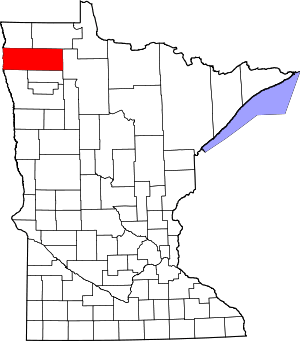Warrenton Township, Marshall County, Minnesota
Warrenton Township is a township in Marshall County, Minnesota, United States. The population was 93 at the 2000 census.
Warrenton Township, Minnesota | |
|---|---|
 Warrenton Township, Minnesota Location within the state of Minnesota | |
| Coordinates: 48°14′45″N 96°48′56″W | |
| Country | United States |
| State | Minnesota |
| County | Marshall |
| Area | |
| • Total | 35.5 sq mi (91.8 km2) |
| • Land | 35.5 sq mi (91.8 km2) |
| • Water | 0.0 sq mi (0.0 km2) |
| Elevation | 846 ft (258 m) |
| Population (2000) | |
| • Total | 93 |
| • Density | 2.6/sq mi (1.0/km2) |
| Time zone | UTC-6 (Central (CST)) |
| • Summer (DST) | UTC-5 (CDT) |
| FIPS code | 27-68206[1] |
| GNIS feature ID | 0665918[2] |
History
Warrenton Township was organized in 1879, and named for Charles H. Warren, a railroad official.[3]
Geography
According to the United States Census Bureau, the township has a total area of 35.5 square miles (91.8 km²), all of it land.
Demographics
At the 2000 census there were 93 people in 31 households, including 27 families, in the township. The population density was 2.6 people per square mile (1.0/km²). There were 38 housing units at an average density of 1.1/sq mi (0.4/km²). The racial makeup of the township was 98.92% White and 1.08% Native American.[1] Of the 31 households 48.4% had children under the age of 18 living with them, 80.6% were married couples living together, 6.5% had a female householder with no husband present, and 12.9% were non-families. 12.9% of households were one person and 3.2% were one person aged 65 or older. The average household size was 3.00 and the average family size was 3.30.
The age distribution was 35.5% under the age of 18, 1.1% from 18 to 24, 31.2% from 25 to 44, 24.7% from 45 to 64, and 7.5% 65 or older. The median age was 36 years. For every 100 females, there were 138.5 males. For every 100 females age 18 and over, there were 114.3 males.
The median household income was $42,083 and the median family income was $42,500. Males had a median income of $29,375 versus $23,750 for females. The per capita income for the township was $15,356. None of the population or the families were below the poverty line, including no under eighteens and none of those over 64.
References
- "U.S. Census website". United States Census Bureau. Retrieved 2008-01-31.
- "US Board on Geographic Names". United States Geological Survey. 2007-10-25. Retrieved 2008-01-31.
- Upham, Warren (1920). Minnesota Geographic Names: Their Origin and Historic Significance. Minnesota Historical Society. p. 331.
